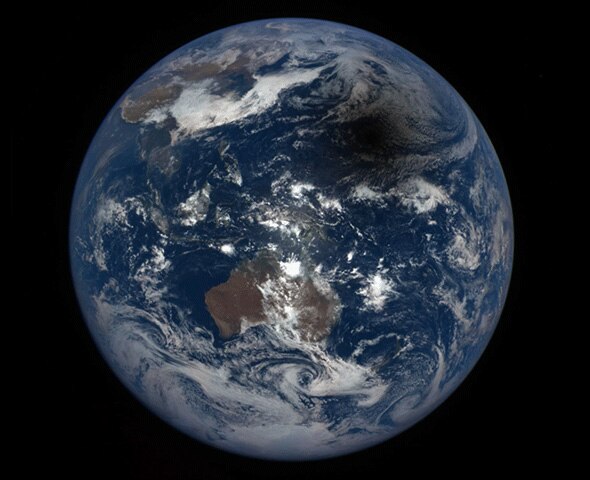Create a free profile to get unlimited access to exclusive videos, sweepstakes, and more!
DSCOVR an Eclipse Seen From Space

Earlier this week, the Moon passed directly in front of the Sun to create a solar eclipse … but only if you were in a very specific place on the planet at the right time. The Moon’s shadow on the Earth is small, so if you weren’t on the eclipse path, you saw a partial eclipse, or none at all.
… unless you weren’t on the Earth in the first place. The DSCOVR satellite is 1.5 million kilometers away from our planet, between the Earth and Sun. It looks back at us to provide a stunning and scientifically important four megapixel natural-color view of the world. It had just about the best seat in the house to view the entire event:
Holy wow. Thirteen images taken over the duration of the eclipse were assembled to create that animation. The Moon’s shadow is the dark spot that moves from left to right. The eclipse took place over the Pacific, and you can see China, Australia, and more under the clouds.
One thing I love about this is that it shows how a solar eclipse is a local event; it only happens where the shadow falls on the Earth, and because the Moon is smaller than Earth and far away, the shadow is small. If you’re on the wrong spot on the Earth, you miss it.
The motions here fascinate me, too. The Earth is rotating left to right (west to east). The Moon is moving in the same direction, off-frame, as it orbits the Earth. It moves around us at about 1 km/sec, so its ground track (the speed it moves across the ground) is actually faster than the Earth’s rotation (which at a maximum is about 0.5 km/sec; there’s a lot of detail here I’m skipping to make the point). So the shadow moves left to right as well, outpacing the surface below it.
And all this is seen from a satellite that appears stationary but isn’t. DSCOVR is in what’s called a halo orbit around the L1 point. This point is in between the Earth and Sun, where the gravitational balance of the Earth and Sun is equal, when you also account for the centripetal acceleration (or centrifugal force if you prefer) of the satellite’s orbit. The point is, all the forces balance and the satellite stays near that spot in space.
Kinda. It actually orbits the L1 point (I refer you to an article at the Planetary Society for more on that), moving around it. If DSCOVR were exactly in the L1 point, then the Earth, Moon, and Sun and satellite would have all been in a line, and you would have seen the Moon pass over the Earth in the animation. But DSCOVR was off that line a bit, so you don’t see the Moon, just the shadow.
This can get a little head-scratchy because of all the angles. For example, it’s possible that from DSCOVR’s viewpoint it does see the Moon pass in front of (what we call transiting) Earth, but there’s no eclipse! That happened in August of 2015:
Amazing. Next year, on Aug. 21, there will be a total solar eclipse that passes right across the U.S. I’m hoping this will be my very first one I’ll ever see; I’ve never been in the right place at the right time. I’ll be writing a lot more about that as the time approaches.
I’ll be on the Earth’s surface when that happens, and I hope we’ll also get images from space by DSCOVR. But you can also be in between: A few lucky people were on an Alaska Air flight which diverted a bit to fly into the path of this last eclipse, and passengers got to see it from the air. The result is, well, see for yourself, in a video that is as delightful in the reactions you hear as the view is stunning.


























